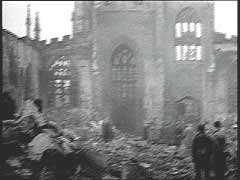<< Previous | Displaying results 1826-1850 of 6707 for "" | Next >>
-
Nazi anti-Jewish boycott
FilmSoon after the Nazis assumed power in Germany, they launched a campaign to deprive Jews of their place in society. The effort began with an organized boycott of Jewish-owned businesses. Gangs arrested Jews, painted "Jews forbidden" onto shop windows, chanted antisemitic slogans, and blocked store entrances.
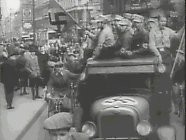
-
Moving into the Krakow ghetto
FilmThe German army occupied Krakow, Poland, in September 1939. In March 1941, the Germans ordered the establishment of a ghetto in Krakow. In this footage, Polish Jews are forced to move into the Krakow ghetto. They wear the required armbands, used to distinguish the Jewish population from the rest of the city's residents. By late 1941, there were some 18,000 Jews imprisoned in the Krakow ghetto.
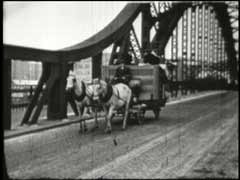
-
Daily life in the Warsaw ghetto
FilmA bridge connected areas of the Warsaw ghetto to prevent Jews from entering the streets that were not part of the ghetto. Before the ghetto was sealed, the few entrances and exits had checkpoints. In the early months of the ghetto, life had the appearance of normalcy, but very soon the lack of food and adequate housing began to take its toll.
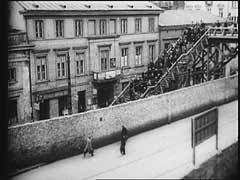
-
Lodz ghetto
FilmThe German army occupied Lodz, Poland, in September 1939. From early February 1940, Jews in Lodz were forced to move to a designated ghetto area, which was sealed on April 30, 1940. This German footage illustrates conditions during winter in the Lodz ghetto. Winter in the ghettos aggravated existing hardships, depleting already sparse supplies of food and fuel.
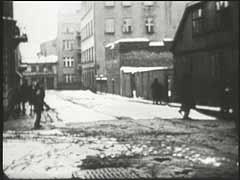
-
Fall of Warsaw
FilmGerman troops reached parts of Warsaw on September 8 and 9, 1939. During the German siege of Warsaw, the city sustained heavy damage from air attacks and artillery shelling. Warsaw surrendered on September 28. Here, German troops occupy Warsaw. This footage comes from "Tale of a City," a film made by a Polish underground film unit.
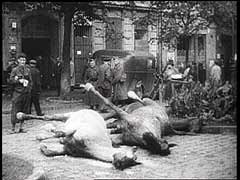
-
Conditions in the Warsaw ghetto
FilmAfter the Germans established the Warsaw ghetto in October 1940, conditions deteriorated rapidly. The Germans strictly controlled the movement of goods into and out of the ghetto. There was not enough food to feed the ghetto residents. At great personal risk, many Jews attempted to smuggle in food. The German food ration for Warsaw ghetto inhabitants amounted to less than 10 percent of the ration for a German citizen. Thousands of Jew died in Warsaw each month because of starvation or disease.
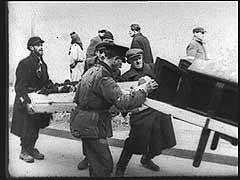
-
Conditions in the Warsaw ghetto
FilmThe Nazis sealed the Warsaw ghetto in mid-November 1940. German-induced overcrowding and food shortages led to an extremely high mortality rate in the ghetto. Almost 30 percent of the population of Warsaw was packed into 2.4 percent of the city's area. The Germans set a food ration for Jews at just 181 calories a day. By August 1941, more than 5,000 people a month succumbed to starvation and disease.
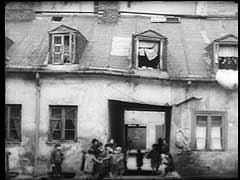
-
Conditions in the Warsaw ghetto
FilmThe Nazis sealed the Warsaw ghetto in mid-November 1940. German-induced overcrowding and food shortages led to an extremely high mortality rate in the ghetto. Almost 30 percent of the population of Warsaw was packed into 2.4 percent of the city's area. The Germans set a food ration for Jews at just 181 calories a day. By August 1941, more than 5,000 people a month succumbed to starvation and disease.
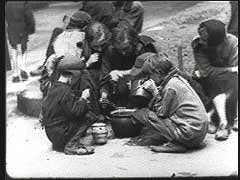
-
Prison in the Warsaw ghetto
FilmAfter the Germans established the Warsaw ghetto in 1940, the Jewish council in Warsaw became responsible for the full range of city services inside the ghetto area. In this German footage, prisoners from the ghetto's "Jewish prison" run into the courtyard and walk in circles during inspection.

-
Adam Czerniakow, chairman of the Jewish council in Warsaw
Film[This video is silent] German forces entered Warsaw in September 1939. The next month, they ordered the establishment of a Jewish council (Judenrat) in the city. They chose Adam Czerniakow, a member of Warsaw's old Jewish Community Council, to lead it. Here, for German newsreels, a German propaganda company stages a meeting between Czerniakow and petitioners from the ghetto. The Germans expected Czerniakow to implement German orders, including demands for forced labor and confiscations of Jewish-owned…
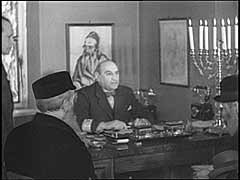
-
Jewish deportees from Magdeburg in the Warsaw ghetto
FilmBeginning in 1941, the Germans deported Jews in Germany to the occupied eastern territories. At first, they deported thousands of Jews to ghettos in Poland and the Baltic states. Those deported would share the fate of local Jews. Later, many deportation transports from Germany went directly to the killing centers in occupied Poland. In this footage, a German propaganda unit films recent arrivals from Magdeburg, Germany, in a collection center run by the Jewish council in the Warsaw ghetto. In July 1942,…
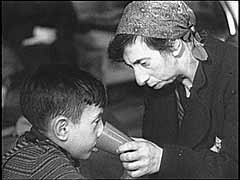
-
German forces enter Warsaw
FilmGermany invaded Poland on September 1, 1939, beginning World War II. German forces swiftly overran Polish border defenses and approached Warsaw, Poland's capital city. Warsaw suffered heavy air attacks and artillery bombardments during the campaign. The city surrendered on September 28. This footage shows German forces entering Warsaw amidst the destruction caused by their bombardment of the city.

-
German victory parade in Warsaw
FilmGermany invaded Poland on September 1, 1939. The Blitzkrieg ("lightning war") campaign in Poland was short and decisive. Warsaw, the capital of Poland, surrendered on September 27. In early October, Adolf Hitler visited Warsaw to review his forces. This footage shows victorious German army units parading before Hitler in the streets of the devastated city.
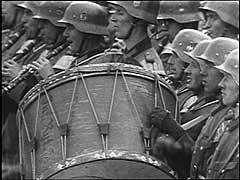
-
Aftermath of pogrom in Kielce
FilmA pogrom took place in Kielce, Poland, in July 1946. Forty-two Jews were massacred and about 50 more were wounded. The event touched off a mass migration of hundreds of thousands of Jews from Poland and other countries of eastern and central Europe. This clip shows Jewish refugees, survivors of the pogrom, waiting to leave Poland and crossing into Czechoslovakia.
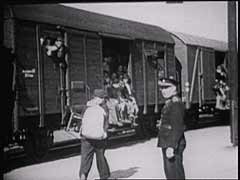
-
Displaced persons camp in Austria
FilmAfter World War II, the Allies repatriated millions of displaced persons (DPs) back to their countries of origin. But hundreds of thousands of people, including more than 250,000 Jewish refugees, could not or would not return. Most Jewish DPs preferred to leave Europe for either Palestine or the United States. The United Nations Relief and Rehabilitation Administration (UNRRA) housed them in camps in occupied Germany and Austria until they could be resettled. Here, Jewish DPs raise their children in the…
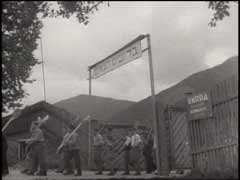
-
Zionist protest rally in Zeilsheim camp
FilmAfter World War II, the Allies repatriated millions of displaced persons (DPs) to their countries of origin. But hundreds of thousands of people, including more than 250,000 Jewish refugees, could not or would not return. Most Jewish DPs preferred to leave Europe for either Palestine or the United States. The Allies housed them in camps in occupied Germany until they could be resettled. Here, Jewish Zionists protest their continued confinement in Zeilsheim displaced persons camp in Germany. They demand…
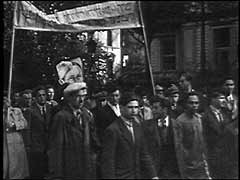
-
Displaced persons leave for the United States
FilmAt the end of World War II, the Allied powers in Europe repatriated from Germany millions of displaced persons (DPs). The remaining 1.5 to 2 million DPs—both Jews and non-Jews—refused or were unable to return to their prewar homes. Immigration restrictions precluded the large-scale admission of these refugees to other European countries and the United States. They remained in occupied Germany until they could arrange to settle in another country. In this footage, filmed more than four years…
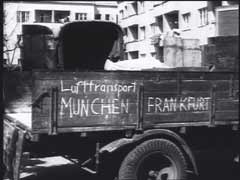
-
Einsatzgruppen in Liepaja, Latvia
FilmGerman Einsatzgruppen operated in German-occupied territories in eastern Europe during World War II. This rare footage shows a unit during a massacre in Liepaja, Latvia. The film was taken, contrary to orders, by a German soldier. Before the war, the Jewish population of Liepaja stood at more than 7,000 residents. Einsatzgruppen shot almost the entire Jewish population of the town. When the Soviet army liberated the city in 1945, just 20 to 30 Jews remained. Einsatzgruppen carried out various security…

-
Liberation of Majdanek
FilmIn July 1944, Soviet forces liberated the Majdanek extermination camp. The Polish-Soviet Nazi Crimes Investigation Commission, established to document Nazi atrocities committed during the German occupation of Poland, ordered exhumations at Majdanek as part of its efforts to investigate Nazi mass killings in the camp. The commission later published its findings in Moscow on September 16, 1944, in Polish, Russian, English, and French.
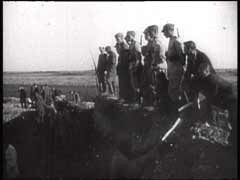
-
Liberation of Auschwitz: Child survivors
FilmSoviet military footage showing children who were liberated at Auschwitz by the Soviet army in January 1945.
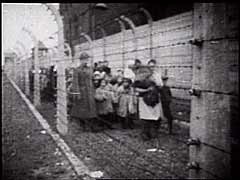
-
Liberation of Dachau
FilmThe Dachau concentration camp, northwest of Munich, Germany, was the first regular concentration camp the Nazis established in 1933. About twelve years later, on April 29, 1945, US armed forces liberated the camp. There were about 30,000 starving prisoners in the camp at the time. Here, soldiers of the US Seventh Army document conditions in the camp. They also require German civilians to tour the camp and confront Nazi atrocities.
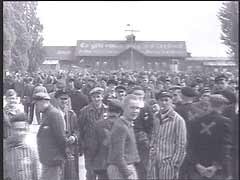
-
Aftermath of the liberation of a forced-labor camp in Germany
Film[This video is silent] There were three large forced-labor camps in Hannover, a large industrial city in northern Germany. All three of the camps were part of the Neuengamme concentration camp system. In early April 1945, American forces entered Hannover and freed the surviving prisoners. The American Signal Corps filmed one of the Hannover camps soon after liberation. American forces fed survivors of the camp and required German civilians to help bury the dead.
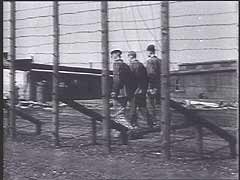
-
Liberation of Mauthausen and Gusen
FilmThis film footage is excerpted from documentary film titled "Mauthausen Concentration Camp," showing footage from both Mauthausen and the nearby Gusen camp. Filmed by US cameramen, the footage opens with a broad view of buildings in the Gusen camp. Excerpts that follow show scenes in the camps, American care of the liberated prisoners, and Austrian civilians loading bodies of victims onto carts for burial.

-
Swastika flag rises over Versailles and Paris
FilmThe German western campaign into the Low Countries and France shattered Allied lines. Within six weeks, Britain evacuated its forces from the Continent and France requested an armistice with Germany. Paris, the French capital, fell to the Germans on June 14, 1940. In this footage, triumphant German forces raise the swastika flag over Versailles and over the Eiffel Tower in Paris. Versailles, the traditional residence of French kings, was deeply symbolic for the Germans: it was the site of both the…
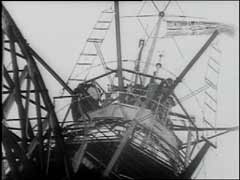
-
Germans bomb Coventry
FilmOn the night of November 14-15, 1940, almost 500 German bombers attacked the British industrial city of Coventry in central England. The bombers dropped 150,000 incendiary bombs and more than 500 tons of high explosives. The air raid destroyed much of the city center, including 12 armament factories and the historic Saint Michael's Cathedral. This footage shows scenes from the aftermath of the attack. The bombing of Coventry came to symbolize, to Britain, the ruthlessness of modern air warfare.
